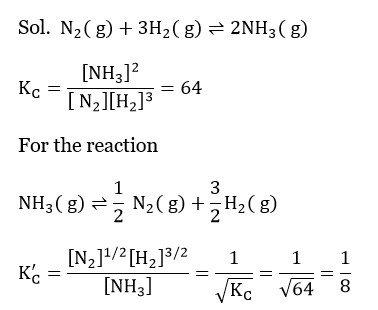Class 11th
Get insights from 8k questions on Class 11th, answered by students, alumni, and experts. You may also ask and answer any question you like about Class 11th
Follow Ask QuestionQuestions
Discussions
Active Users
Followers
New answer posted
2 months agoContributor-Level 10
Since AM of two positive quantities ≥ their G.M.
(2^sinx + 2^cosx)/2 ≥ √ (2^sinx * 2^cosx)
= √ (2^ (sinx+cosx)
= √2^ (√2cos (x-π/4)
≥ √2^ (-√2) ⇒ 2^sinx + 2^cosx ≥ 2 · 2^ (-1/√2) = 2^ (1-1/√2)
New answer posted
2 months agoContributor-Level 10
By family of circle, passing through intersection of given circle will be member of S + λS? = 0 family (λ ≠ 1)
(x² + y² – 6x) + λ (x² + y² – 4y) = 0
(λ + 1)x² + (λ + 1)y² – 6x – 4λy = 0
x² + y² - 6/ (λ+1) x - 4λ/ (λ+1) y = 0
Centre (3/ (λ+1), 2λ/ (λ+1)
Centre lies on 2x – 3y + 12 = 0
2 (3/ (λ+1) - 3 (2λ/ (λ+1) + 12 = 0
6λ + 18 = 0
λ = -3
Circle x² + y² – 3x – 6y = 0
New answer posted
2 months agoContributor-Level 10
Given: 3α² – 10α + 27λ = 0
3α² – 3α + 6λ = 0
Subtract -7α + 21λ = 0
3λ = 0
By (ii) 9λ² – 3λ + 2λ = 0
⇒ λ = 0, 1/9
∴ α = 1/3, β = 2/3, α = 1/3, γ = 3
∴ (βγ)/λ = (2/3) * 3) / (1/9) = 18
New answer posted
2 months agoContributor-Level 10
N+5C_ {R-1}: N+5C_R: N+5C_ {R+1}
= 5:10:4
2 (N+5C_ {R-1}) = N+5C_R ⇒ 3R = N + 6
7 (N+5C_R) = 5 (N+5C_ {R+1}) ⇒ 12R = 18 + 5N
Solving: N = 6, R = 4
∴ the largest coefficient is N+5C_ {R+1} = 11C_5 = 462
New answer posted
2 months agoContributor-Level 10
= [√3e^ (iπ/3)]^4
= 9 (cos (2π/3) + isin (2π/3)
= -9/2 + 9√3i/2
⇒ 0 + 9 (-1 + i√3)/2)
∴ a = 0, b = 9
New question posted
2 months agoNew answer posted
2 months agoContributor-Level 10
Dihydrogen of high degree of purity (>99.95%) is obtained by the electrolysis of warm aqueous barium hydroxide solution between nickel electrodes.
New answer posted
2 months agoContributor-Level 10
³? Cl ³? Cl
Molar ratio x 1 – x
M? 35 * x + 37 (1 − x) = 35.5
35x + 37 – 37x = 35.5
2x = 1.5
x = 3/4
So, ratio of ³? Cl: ³? Cl = 3: 1
Taking an Exam? Selecting a College?
Get authentic answers from experts, students and alumni that you won't find anywhere else
Sign Up on ShikshaOn Shiksha, get access to
- 65k Colleges
- 1.2k Exams
- 679k Reviews
- 1800k Answers

